Monolithic 1 × 8 DWDM Silicon Optical Transmitter Using an Arrayed-Waveguide Grating and Electro-Absorption Modulators for Switch Fabrics in Intra-Data-Center Interconnects
Abstract
:1. Introduction
2. Device Design and Fabrication
2.1. Silicon Waveguide and Electro-Absorption Modulator Using a Schottky Diode
2.2. Silicon DWDM Transmitter for Switch Fabrics in Intra-Data-Center Interconnects
3. Experimental Results
3.1. Characteristics of a Silicon EAM Using a Schottky Diode
3.2. Characteristics of a Silicon Transmitter with Eight EAMs
4. Conclusions
Author Contributions
Funding
Conflicts of Interest
References
- Cisco. Visual Networking Index: Forecast and Methodology, 2016–2021. 2017. Available online: http://www.cisco.com/c/en/us/solutions/collateral/service-provider/visual-networking-index-vni/complete-white-paper-c11-481360.html (accessed on 1 November 2020).
- Cisco. Global Cloud Index: Forecast and Methodology, 2015–2020. 2016. Available online: https://www.cisco.com/c/dam/en/us/solutions/collateral/service-provider/global-cloud-index-gci/white-paper-c11-738085.pdf (accessed on 1 November 2020).
- Li, Y.; Zhang, L.; Zhang, Y.; Wang, J. Silicon and hybrid silicon photonic devices for intra-datacenter applications: State of the art and perspectives. Photonics Res. 2015, 3, B10–B27. [Google Scholar] [CrossRef]
- Kottke, C.; Caspar, C.; Jungnickel, V.; Freund, R.; Agustin, M.; Ledentsov, N.N. High Speed 160 Gb/s DMT VCSEL Transmission Using Pre-equalization. In Proceedings of the Optical Fiber Communication Conference, Los Angeles, CA, USA, 19–23 March 2017; p. W4I.7. [Google Scholar]
- Dong, P.; Chen, Y.-K.; Duan, G.-H.; Neilson, D.T. Silicon photonic devices and integrated circuits. Nanophotonics 2014, 3, 215–228. [Google Scholar] [CrossRef]
- Mori, Y.; Sato, K.-I. Large-Scale Optical Circuit Switch Architecture for Intra-Datacenter Networking. In Proceedings of the Optical Fiber Communication Conference, San Diego, CA, USA, 11–15 March 2018; p. Th3H.3. [Google Scholar]
- Eramo, V. Comparison in Power Consumption of Synchronous and Asynchronous Optical Packet Switches. J. Light. Technol. 2010, 28, 847–857. [Google Scholar] [CrossRef]
- Eramo, V.; Listanti, M.; Sabella, R.; Testa, F. Integrated OTN/WDM Switching Architecture Equipped with the Minimum Number of OTN Switches. J. Opt. Commun. Netw. 2014, 6, 138–151. [Google Scholar] [CrossRef]
- Jalali, B. Silicon photonics. Optoelectron. High-Power Laser Appl. 1997, 3290, 238–245. [Google Scholar] [CrossRef]
- Jahani, S.; Kim, S.; Atkinson, J.; Wirth, J.C.; Kalhor, F.; Al Noman, A.; Newman, W.D.; Shekhar, P.; Han, K.; Van, V.; et al. Controlling evanescent waves using silicon photonic all-dielectric metamaterials for dense integration. Nat. Commun. 2018, 9, 1–9. [Google Scholar] [CrossRef]
- Stojanovic, V.; Ram, R.J.; Popović, M.; Lin, S.; Moazeni, S.; Wade, M.; Sun, C.; Alloatti, L.; Atabaki, A.; Pavanello, F.; et al. Monolithic silicon-photonic platforms in state-of-the-art CMOS SOI processes. Opt. Express 2018, 26, 13106–13121. [Google Scholar] [CrossRef] [Green Version]
- Yamazaki, H.; Yamada, T.; Suzuki, K.; Goh, T.; Kaneko, A.; Sano, A.; Yamada, E.; Miyamoto, Y. Integrated 100-Gb/s PDM-QPSK modulator using a hybrid assembly technique with silica-based PLCs and LiNbO3 phase modulators. In Proceedings of the 34th European Conference on Optical Communication, Brussels, Belgium, 21–25 September 2008; pp. 1642–1662. [Google Scholar]
- Yamada, E.; Kanazawa, S.; Ohki, A.; Watanabe, K.; Nasu, Y.; Kikuchi, N.; Shibata, Y.; Iga, R.; Ishii, H. 112-Gb/s InP DP-QPSK Modulator Integrated with a Silica-PLC Polarization Multiplexing Circuit. In Proceedings of the National Fiber Optic Engineers Conference, Los Angeles, CA, USA, 4–8 March 2012; p. PDP5A-9. [Google Scholar]
- Kurata, Y.; Nasu, Y.; Tamura, M.; Kasahara, R.; Aozasa, S.; Mizuno, T.; Yokoyama, H.; Tsunashima, S.; Muramoto, Y.; Tsunashiama, S. Silica-Based PLC with Heterogeneously-Integrated PDs for One-Chip DP-QPSK Receiver. Eur. Conf. Exhib. Opti. Comm. 2012, 20, B264–B269. [Google Scholar] [CrossRef]
- Wang, J.; Kroh, M.; Theurer, A.; Zawadzki, C.; Schmidt, D.; Ludwig, R.; Lauermann, M.; Zhang, Z.; Beling, A.; Matiss, A.; et al. Dual-quadrature coherent receiver for 100G Ethernet applications based on polymer planar lightwave circuit. Opt. Express 2011, 19, B166–B172. [Google Scholar] [CrossRef]
- Nasu, Y.; Mizuno, T.; Kasahara, R.; Saida, T. Temperature insensitive and ultra wideband silica-based dual polarization optical hybrid for coherent receiver with highly symmetrical interferometer design. Opt. Express 2011, 19, B112–B118. [Google Scholar] [CrossRef]
- Xiong, C.; Gill, D.M.; Proesel, J.E.; Orcutt, J.S.; Haensch, W.; Green, W.M.J. Monolithic 56 Gb/s silicon photonic pulse-amplitude modulation transmitter. Optica 2016, 3, 1060–1065. [Google Scholar] [CrossRef]
- Marris-Morini, D.; Rasigade, G.; Vivien, L.; Thomson, D.J.; Gardes, F.Y.; Reed, G.T.; Fedeli, J.-M.; Crozat, P.; Cassan, E. Carrier depletion based silicon optical modulators. Photonics Eur. 2010, 7719, 771903. [Google Scholar] [CrossRef]
- Ning, F.; Shirong, L.; Dazeng, F.; Xin, W.; Po, D.; Hong, L.; Cheng, K.; Wei, Q.; Yong, L.; Joan, F.; et al. Design and fabrication of 3μm silicon-on-insulator waveguide integrated Ge electroabsorption modulator. Optics Express. 2011, 19, 8715–8720. [Google Scholar]
- Elshaari, A.W.; Preble, S.F. 10 Gb/s broadband silicon electro-optic absorption modulator. Opt. Commun. 2010, 283, 2829–2834. [Google Scholar] [CrossRef]
- Pan, P.; An, J.; Wang, Y.; Zhang, J.; Wang, L.; Qi, Y.; Han, Q.; Hu, X. Compact 4-channel AWGs for CWDM and LAN WDM in data center monolithic applications. Opt. Laser Technol. 2015, 75, 177–181. [Google Scholar] [CrossRef]
- Xu, H.; Shi, Y. Flat-Top CWDM (De)Multiplexer Based on MZI With Bent Directional Couplers. IEEE Photonics Technol. Lett. 2017, 30, 169–172. [Google Scholar] [CrossRef]
- Chen, C.-H.; Seyedi, M.A.; Fiorentino, M.; Livshits, D.; Gubenko, A.; Mikhrin, S.; Mikhrin, V.; Beausoleil, R.G. A comb laser-driven DWDM silicon photonic transmitter based on microring modulators. Opt. Express 2015, 23, 21541–21548. [Google Scholar] [CrossRef]
- Gupta, R.K.; Chandran, S.; Krishna, B. Integrated silicon photonics directional couplers for WDM applications. In Proceedings of the 2018 3rd International Conference on Microwave and Photonics (ICMAP), Dhanbad, India, 9–11 February 2018; pp. 1–2. [Google Scholar]
- Kanakis, G.; Iliadis, N.; Soenen, W.; Moeneclaey, B.; Argyris, N.; Kalavrouziotis, D.; Spiga, S.; Bakopoulos, P.; Avramopoulos, H. High-Speed VCSEL-Based Transceiver for 200 GbE Short-Reach Intra-Datacenter Optical Interconnects. Appl. Sci. 2019, 9, 2488. [Google Scholar] [CrossRef] [Green Version]
- Hiraki, T.; Aihara, T.; Nishi, H.; Tsuchizawa, T. Deuterated SiN/SiON Waveguides on Si Platform and Their Application to C-Band WDM Filters. IEEE Photonics J. 2017, 9, 1–7. [Google Scholar] [CrossRef]
- Fang, Q.; Song, J.F.; Tao, S.H.; Yu, M.B.; Lo, G.Q.; Kwong, D.L. Low loss (~6.45 dB/cm) sub-micron polycrystalline silicon waveguide integrated with efficient SiON waveguide coupler. Opt. Express 2008, 16, 6425–6432. [Google Scholar] [CrossRef]
- Vivien, L.; Grillot, F.; Cassan, E.; Pascal, D.; Lardenois, S.; Lupu, A.; Laval, S.; Heitzmann, M.; Fedeli, J.-M. Comparison between strip and rib SOI microwaveguides for intra-chip light distribution. Opt. Mater. 2005, 27, 756–762. [Google Scholar] [CrossRef]
- Soref, R.; Bennett, B. Electrooptical effects in silicon. IEEE J. Quantum Electron. 1987, 23, 123–129. [Google Scholar] [CrossRef] [Green Version]
- Gosciniak, J.; Tan, D.T.H. Theoretical investigation of graphene-based photonic modulators. Sci. Rep. 2013, 3, srep01897. [Google Scholar] [CrossRef] [Green Version]
- Gatkine, P.; Veilleux, S.; Hu, Y.; Bland-Hawthorn, J.; Dagenais, M. Arrayed waveguide grating spectrometers for astronomical applications: New results. Opt. Express 2017, 25, 17918–17935. [Google Scholar] [CrossRef] [PubMed]
- Lee, D.H.; Choo, S.J.; Jung, U.; Lee, K.W.; Kim, K.W.; Park, J.H. Low-loss silicon waveguides with sidewall roughness reduction using a SiO2 hard mask and fluorine-based dry etching. J. Micromech. Microeng. 2014, 25, 15003. [Google Scholar] [CrossRef]
- Dong, P.; Liu, X.; Chandrasekhar, S.; Buhl, L.L.; Aroca, R.; Chen, Y.-K. Monolithic Silicon Photonic Integrated Circuits for Compact 100 +Gb/s Coherent Optical Receivers and Transmitters. IEEE J. Sel. Top. Quantum Electron. 2014, 20, 150–157. [Google Scholar] [CrossRef]
- Zepeng, P.; Songnian, F.; Luluzi, L.; Dongyu, L.; Weijie, C.; Deming, L.; Mingming, Z. On-chip cyclic-AWG-based 12 × 12 silicon wavelength routing switches with minimized port-to-port insertion loss fluctuation. Photonics Res. 2018, 6, 380–384. [Google Scholar]
- Ding, R.; Liu, Y.; Li, Q.; Yang, Y.; Ma, Y.; Padmaraju, K.; Lim, A.E.-J.; Lo, G.-Q.; Bergman, K.; Baehr-Jones, T.; et al. Design and characterization of a 30-GHz bandwidth low-power silicon traveling-wave modulator. Opt. Commun. 2014, 321, 124–133. [Google Scholar] [CrossRef]
- Dragone, C. Crosstalk caused by fabrication errors in a generalized Mach-Zehnder interferometer. IEEE Electron. Lett. 1997, 33, 1326–1327. [Google Scholar] [CrossRef]
- Takada, K.; Yamada, H.; Inoue, Y. Origin of channel crosstalk in 100 GHz-spaced silica-based arrayed-waveguide grating multiplexer. Electron. Lett. 1995, 31, 1176–1177. [Google Scholar] [CrossRef]
- Chen, L.; Doerr, C.R.; Dong, P.; Chen, Y.-K. Monolithic silicon chip with 10 modulator channels at 25 Gbps and 100-GHz spacing. Opt. Express 2011, 19, B946–B951. [Google Scholar] [CrossRef]
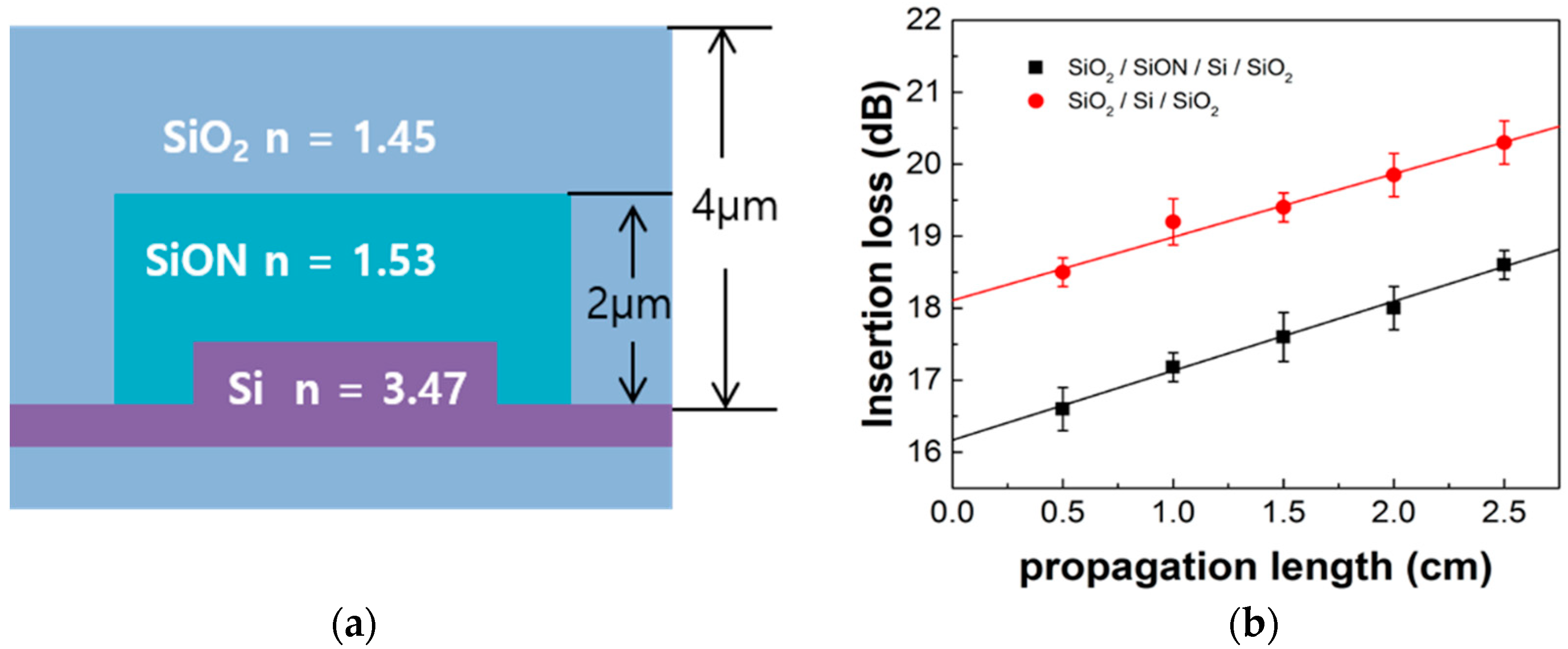
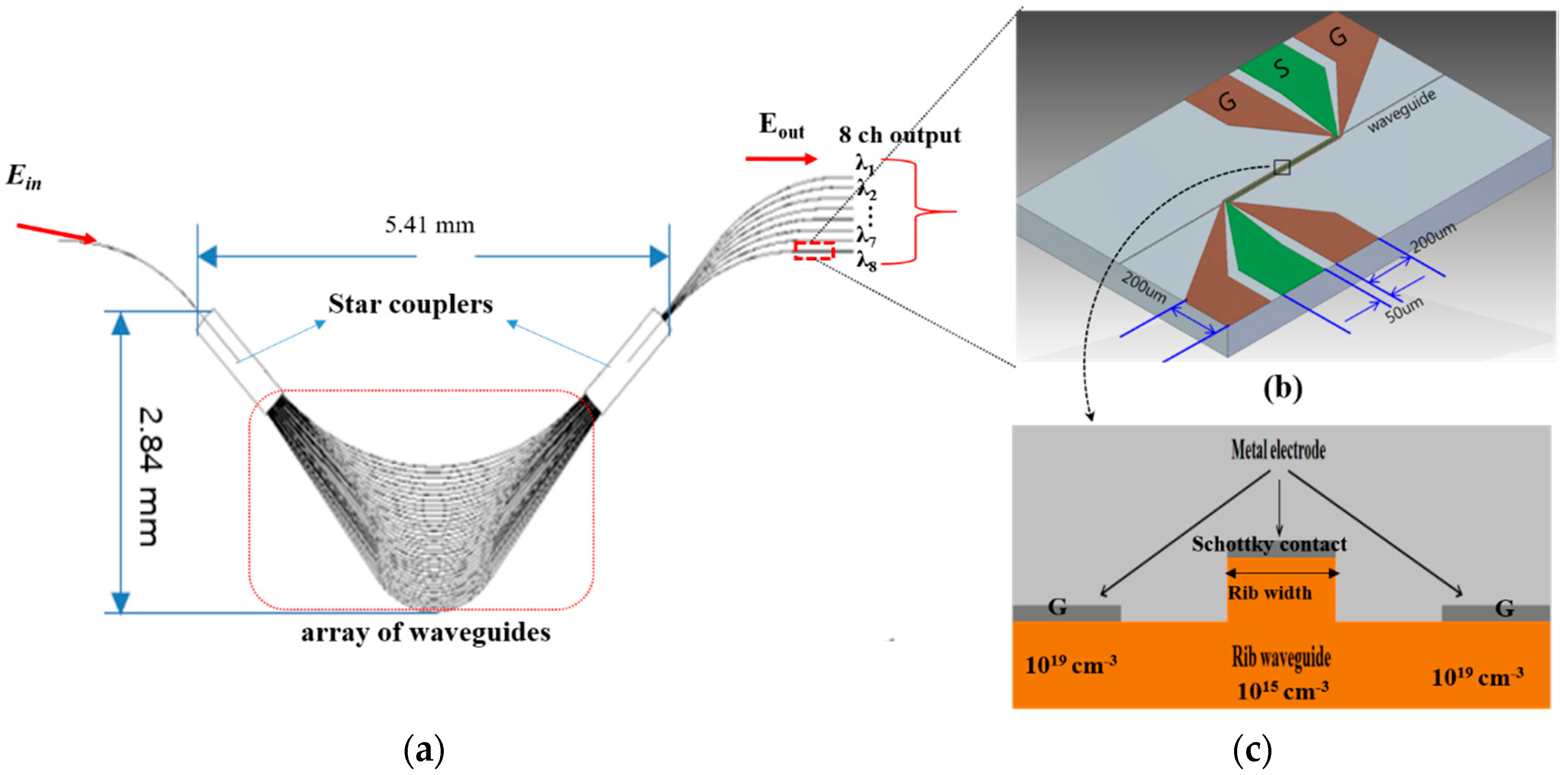
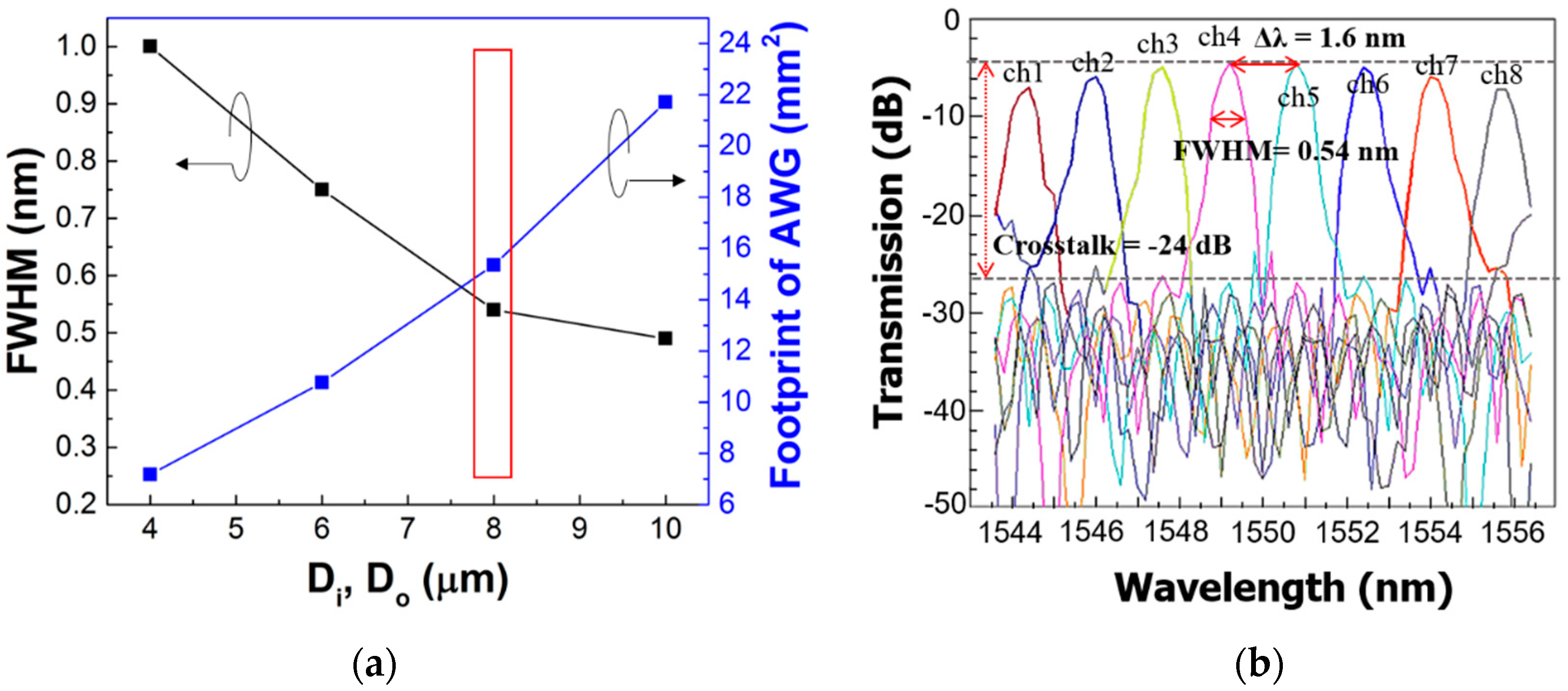
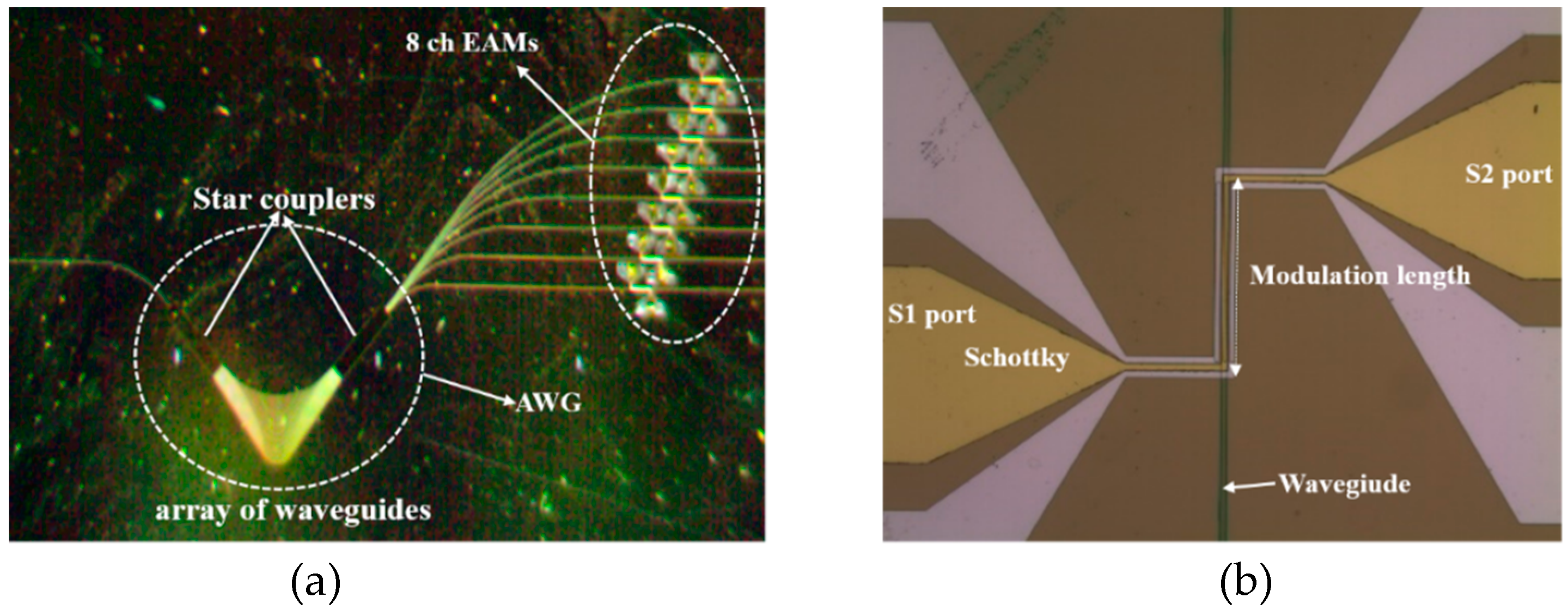
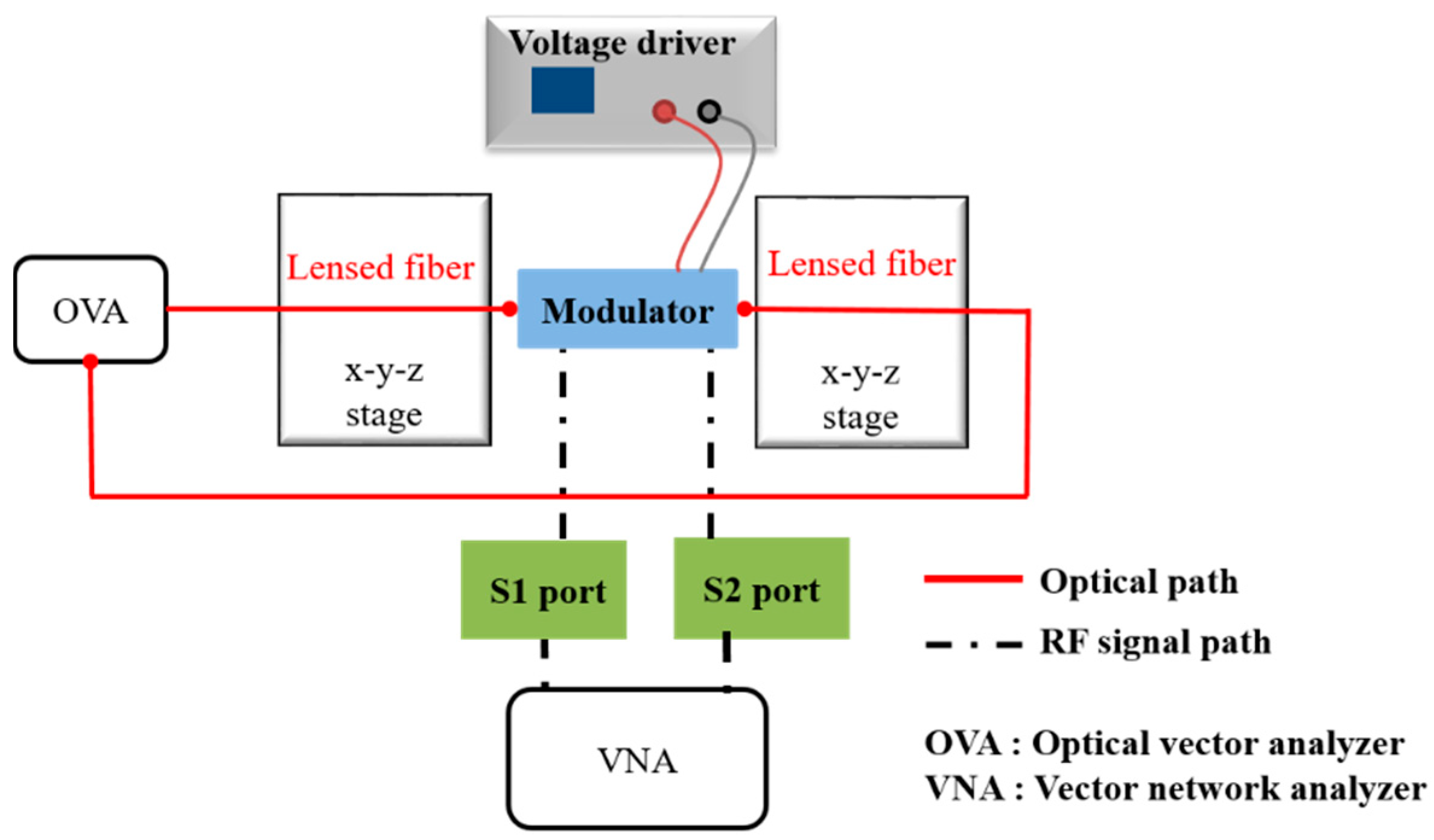
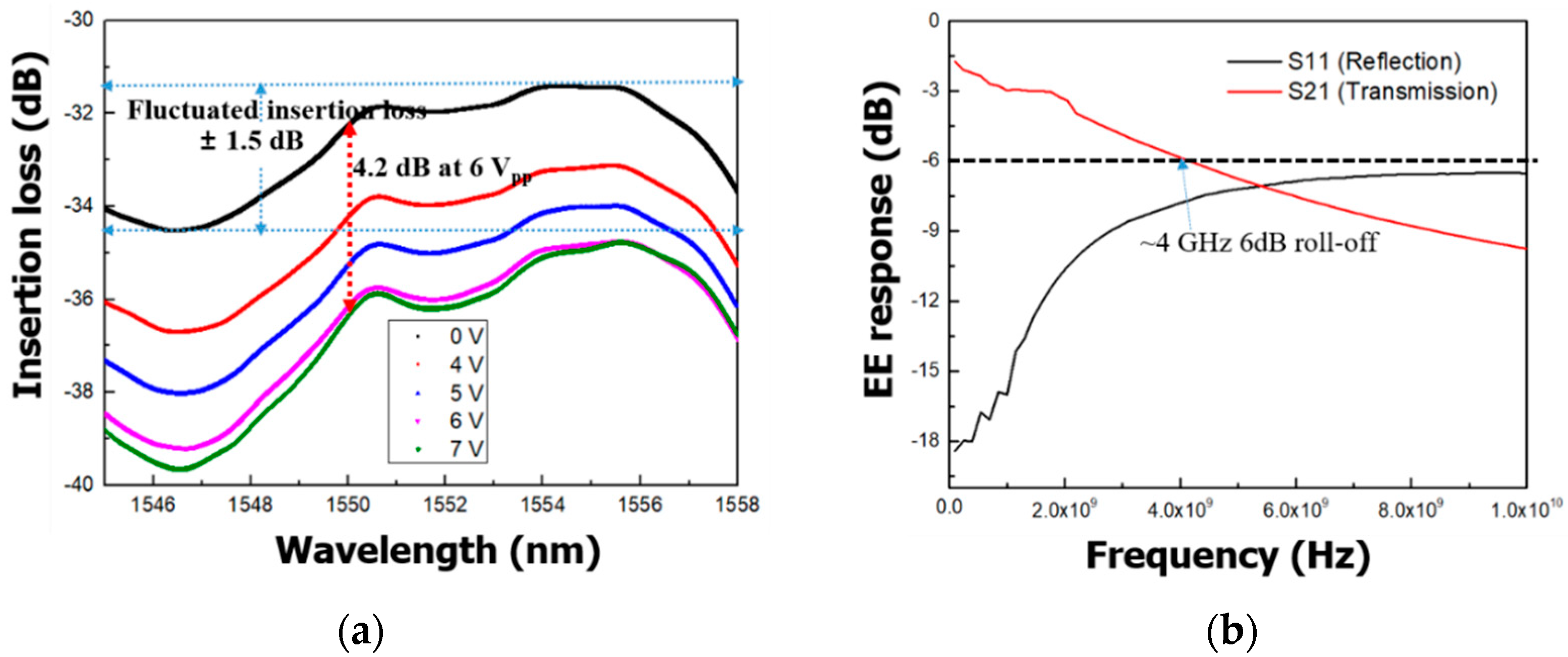

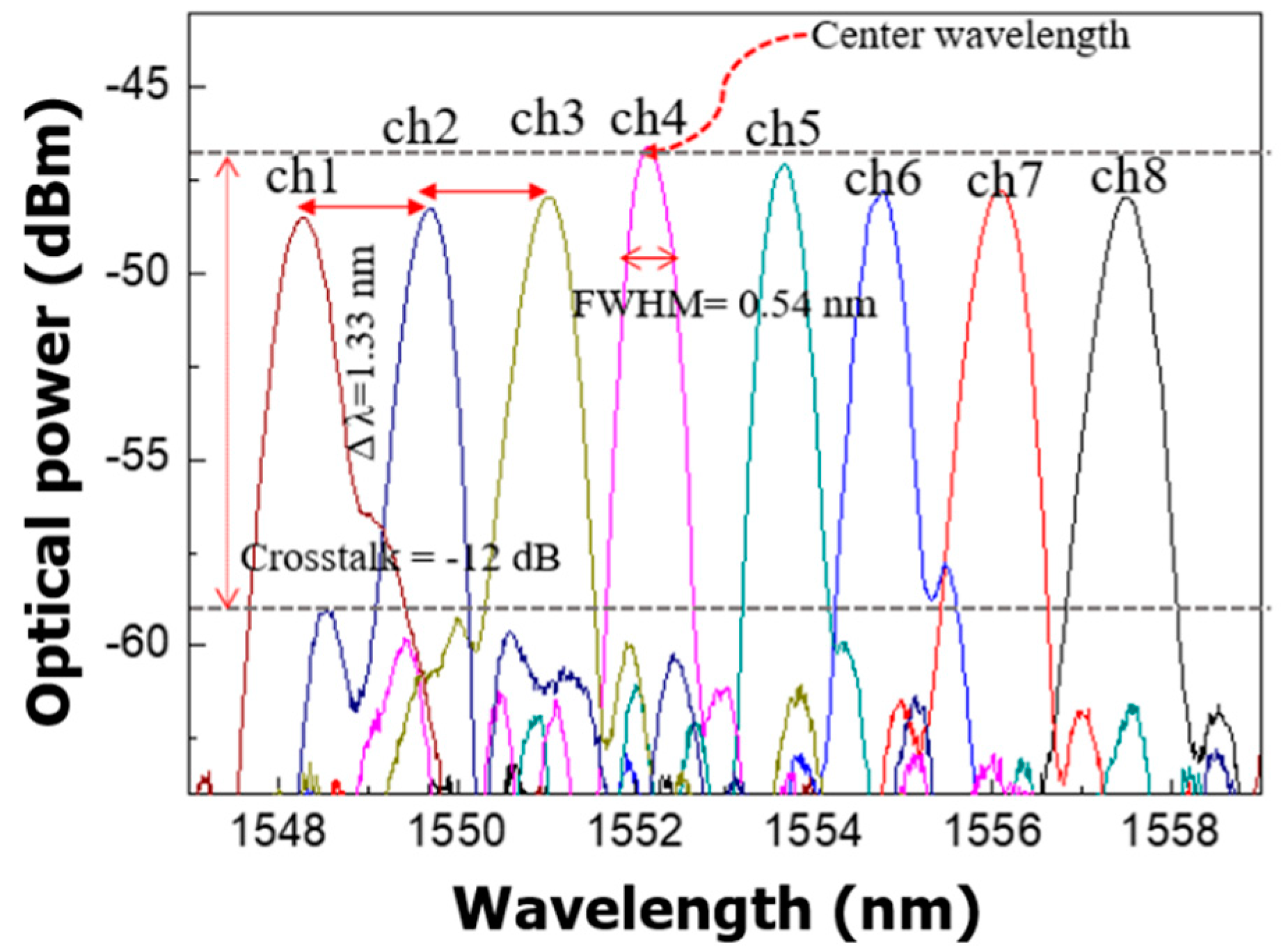

| Parameter | Description | Value |
|---|---|---|
| w | width of rib waveguide | 4.8 μm |
| λc | center wavelength | 1.55 μm |
| Δλ | channel spacing (in wavelength) | 1.6 nm |
| M | number of waveguides in array | 32 |
| Nch | number of output channels | 8 |
| Raw1 | radius of ith innermost waveguide bend in array | 2500 μm |
| Di | waveguide separation at input circle | 4, 6, 8, 10 μm |
| Do | waveguide separation at output circle | 4, 6, 8, 10 μm |
Publisher’s Note: MDPI stays neutral with regard to jurisdictional claims in published maps and institutional affiliations. |
© 2020 by the authors. Licensee MDPI, Basel, Switzerland. This article is an open access article distributed under the terms and conditions of the Creative Commons Attribution (CC BY) license (http://creativecommons.org/licenses/by/4.0/).
Share and Cite
Jeong, U.; Lee, D.H.; Lee, K.; Park, J.H. Monolithic 1 × 8 DWDM Silicon Optical Transmitter Using an Arrayed-Waveguide Grating and Electro-Absorption Modulators for Switch Fabrics in Intra-Data-Center Interconnects. Micromachines 2020, 11, 991. https://doi.org/10.3390/mi11110991
Jeong U, Lee DH, Lee K, Park JH. Monolithic 1 × 8 DWDM Silicon Optical Transmitter Using an Arrayed-Waveguide Grating and Electro-Absorption Modulators for Switch Fabrics in Intra-Data-Center Interconnects. Micromachines. 2020; 11(11):991. https://doi.org/10.3390/mi11110991
Chicago/Turabian StyleJeong, Uiseok, Dong Ho Lee, Kyungwoon Lee, and Jung Ho Park. 2020. "Monolithic 1 × 8 DWDM Silicon Optical Transmitter Using an Arrayed-Waveguide Grating and Electro-Absorption Modulators for Switch Fabrics in Intra-Data-Center Interconnects" Micromachines 11, no. 11: 991. https://doi.org/10.3390/mi11110991




